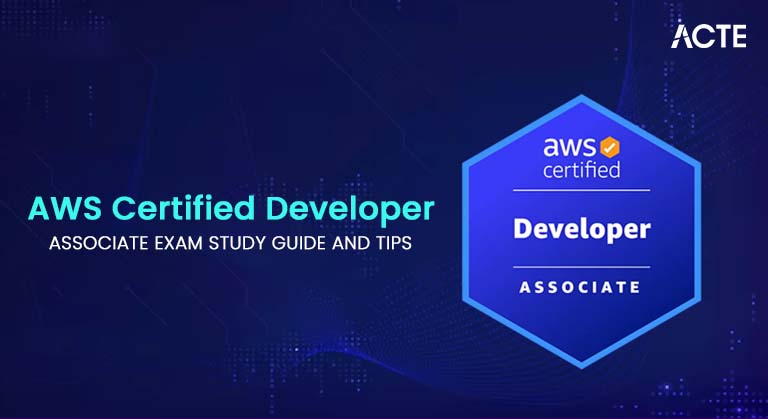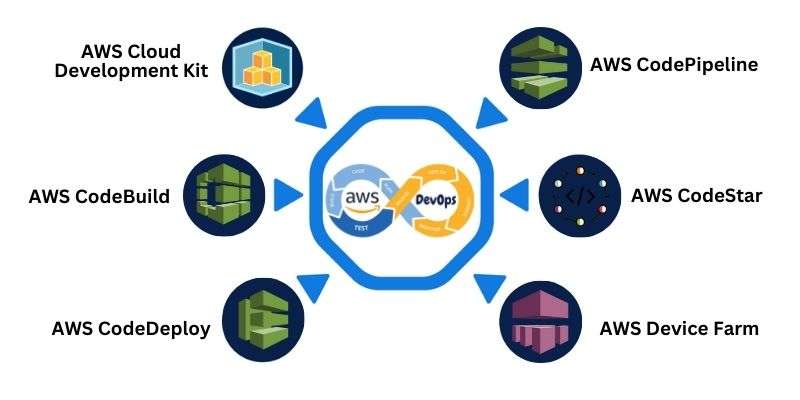
- Introduction to the AWS Certified Developer Associate Exam
- Eligibility and Prerequisites
- Exam Format and Structure
- Key Domains and Exam Objectives
- AWS Compute Services (EC2, Lambda, Elastic Beanstalk)
- AWS Storage and Database Services (S3, DynamoDB, RDS)
- Security Best Practices in AWS Development
- Monitoring and Debugging AWS Applications
- CI/CD and DevOps Tools for AWS Developers
- Recommended Study Materials and Practice Exams
- Career Benefits of AWS Certified Developer Associate Certification
- Final Exam Day Tips and Strategies
- Conclusion
Introduction to the AWS Certified Developer Associate Exam
The AWS Certified Developer—Associate exam is designed for individuals in a development role with hands-on experience designing, developing, deploying, and maintaining applications on Amazon Web Services (AWS). AWS, the world’s leading cloud platform, offers various services that enable developers to build scalable and secure applications. The certification validates your expertise in AWS development tools and services, and it’s a valuable credential for professionals looking to prove their cloud development skills. Achieving the AWS Certified Developer—Associate certification demonstrates that you possess the skills to design, develop, and deploy applications within AWS. It’s suitable for developers with a working knowledge of AWS services and can help professionals advance their careers in cloud development by increasing their knowledge of AWS tools and best practices.
Eligibility and Prerequisites
To sit for the AWS Certified Developer – Associate exam, you should have the following:
- Experience: Ideally, candidates should have at least one year of hands-on experience developing AWS applications. This experience should include using AWS services such as AWS Lambda, S3, EC2, and DynamoDB in real-world projects.
- Knowledge of Key AWS Services: Familiarity with AWS services, including computing, storage, databases, networking, and security, is important. Experience developing applications and managing resources in the cloud will give you a good foundation for the exam.
- Familiarity with Programming: Since the exam focuses on development skills, you should be proficient in at least one programming language, Python, Java, Node.js, or Go, which are commonly used in cloud development.
- No Formal Prerequisite: AWS does not require you to complete specific training before attempting the exam. However, practical experience with AWS services is highly recommended.
Exam Format and Structure
The AWS Certified Developer – Associate exam consists of multiple-choice and multiple-answer questions that assess your understanding and ability to use AWS services to build, deploy, and manage applications. The exam has the following structure:
- Number of Questions: 65 questions.
- Duration: 130 minutes.
- Question Format: Multiple-choice and multiple-answer questions.
- Passing Score: AWS does not publish the exact passing score, but a score of 70% or higher is typically required to pass.
- Cost: The exam costs USD 150.
- Languages: The exam is in English, Japanese, Korean, and Simplified Chinese.
The questions test your ability to solve real-world problems and apply best practices when developing cloud-based applications. These problems will involve theoretical knowledge and practical application of AWS services.

Key Domains and Exam Objectives
The exam is divided into four key domains that represent the knowledge areas you need to master for the certification:
Deployment (22%):- Develop and deploy AWS-based applications using services like Elastic Beanstalk, Lambda, and EC2.
- Utilize AWS tools like CloudFormation and CodeDeploy for continuous integration and deployment (CI/CD). Security (26%):
- Implement security best practices for AWS development, such as using IAM roles and policies, securing application data with encryption, and managing API access through API Gateway. Development (30%):
- Understand how to write and debug code for AWS applications, including working with AWS SDKs, APIs, and CLI tools.
- Work with serverless architectures using AWS services such as AWS Lambda and API Gateway. Refactoring (20%):
- Optimize AWS applications for performance, cost, and scalability. This includes leveraging Elastic Load Balancing (ELB), Auto Scaling, and Amazon CloudWatch for monitoring.
Understanding the domains and their objectives will help guide your study plan and exam preparation.
AWS Compute Services (EC2, Lambda, Elastic Beanstalk)
Amazon EC2 (Elastic Compute Cloud)EC2 is one of the foundational services for running virtual machines on AWS. As a developer, you’ll use EC2 instances to host applications, scale resources, and handle variable workloads. Key concepts to understand include:
- EC2 instance types and families.
- Amazon Machine Images (AMIs).
- EC2 Auto Scaling.
- Security groups and networking. AWS Lambda
- How Lambda works with events from other AWS services like S3, DynamoDB, and API Gateway.
- Managing Lambda functions using the AWS Management Console, CLI, and SDKs.
- Lambda function resource management and execution time limits. Elastic Beanstalk
- Deploy applications to Elastic Beanstalk environments (e.g., web servers, APIs).
- Configure environment settings and manage application versions.
Lambda allows you to run code without provisioning or managing servers, making it a core service for serverless applications. You need to understand:
Elastic Beanstalk is a platform-as-a-service (PaaS) solution that simplifies the deployment of web applications and services. As an AWS Developer, it’s essential to know how to:
AWS Storage and Database Services (S3, DynamoDB, RDS)
Amazon S3 (Simple Storage Service)S3 is used to store and manage data on AWS. Understanding S3’s features, such as:
- Buckets, objects, and access control (IAM policies, bucket policies).
- Versioning, lifecycle policies, and event notifications.
- Integration with other AWS services. Amazon DynamoDB
- Set up tables and manage data in DynamoDB.
- Understand DynamoDB Streams for real-time data processing.
- Optimize queries and performance through the correct table design. Amazon RDS (Relational Database Service)
- Launching and managing RDS instances (MySQL, PostgreSQL, SQL Server, etc.).
- RDS backups, snapshots, and scaling.
- Using RDS with EC2 or Lambda for data access.
DynamoDB is a fully managed NoSQL database service. You need to know how to:
RDS provides managed relational databases. Knowledge areas to focus on include:
Security Best Practices in AWS Development
Security is an essential part of AWS development. Key topics include:
- IAM (Identity and Access Management): Configuring IAM roles, policies, and best practices for securing application resources.
- Encryption: Using encryption at rest and in transit with AWS services such as S3, DynamoDB, and RDS.
- API Security: Securing APIs with AWS API Gateway, Cognito and integrating authentication and authorization mechanisms.
- Security Groups and Network ACLs: Managing network security for EC2 instances and services.
Monitoring and Debugging AWS Applications
As a developer, you must understand how to monitor and debug applications running in the AWS environment. Key services include:
- Amazon CloudWatch: Monitoring the performance and health of AWS resources.
- AWS X-Ray: Tracing and debugging distributed applications, especially for Lambda serverless applications.
- AWS CloudTrail: Keeping track of API calls for auditing purposes.
CI/CD and DevOps Tools for AWS Developers
AWS provides a suite of tools that are essential for CI/CD and DevOps workflows, including:
- AWS CodeCommit: A fully managed source control service.
- AWS CodeBuild: Automating the build process.
- AWS CodeDeploy: Automating application deployments.
- AWS CodePipeline: Orchestrating the CI/CD pipeline.
These tools are integrated with AWS services to streamline application development and deployment in a DevOps model.

Recommended Study Materials and Practice Exams
To prepare effectively for the AWS Certified Developer – Associate exam, it’s essential to use various study resources. Here are some recommended materials:
- AWS Training and Certification: AWS offers free and paid training resources, including video courses and exam readiness sessions.
- A Cloud Guru: Offers interactive and in-depth courses specifically designed for AWS certifications.
- Whizlabs: Practice exams and detailed explanations.
- AWS Whitepapers: Review the official AWS whitepapers on security, architecture, and best practices.
- Books: “AWS Certified Developer – Associate Guide” and other related books that cover in-depth exam topics.
Career Benefits of AWS Certified Developer Associate Certification
Earning the AWS Certified Developer – Associate certification offers numerous career benefits:
- Increased Marketability: AWS certifications are recognized globally, and having one can help you stand out to employers.
- Career Advancement: This certification demonstrates your ability to work with AWS and cloud technologies in high demand.
- Better Salary: AWS-certified professionals earn higher salaries than their non-certified counterparts due to their proven cloud expertise.
- Expanded Knowledge: Preparing for the exam deepens your understanding of AWS services and cloud development best practices, which can enhance your overall career prospects.
Final Exam Day Tips and Strategies
- Review the key concepts: Focus on the exam domains and key services (EC2, Lambda, DynamoDB, etc.). Ensure you’re comfortable using these services in real-world scenarios.
- Take Practice Exams: Completing practice exams will help you familiarize yourself with the exam format and identify areas for improvement.
- Manage Your Time: The exam has 65 questions, so manage your time effectively. Aim to spend about two minutes per question, leaving extra time at the end for review.
- Read Questions Carefully: Ensure you fully understand the question before answering. Some questions may have tricky wording, so stay attentive.
- Use the AWS Console: Use the AWS Console during practice exams to become more comfortable navigating the interface.
Conclusion
The AWS Certified Developer – Associate exam is a valuable certification for developers looking to validate their skills in cloud development. With the proper preparation, including understanding key AWS services and development best practices, you can successfully pass the exam and advance your career in the growing field of cloud computing.





